ABS AUDI A4 AVANT 2008 Owners Manual
[x] Cancel search | Manufacturer: AUDI, Model Year: 2008, Model line: A4 AVANT, Model: AUDI A4 AVANT 2008Pages: 368, PDF Size: 46.19 MB
Page 21 of 368
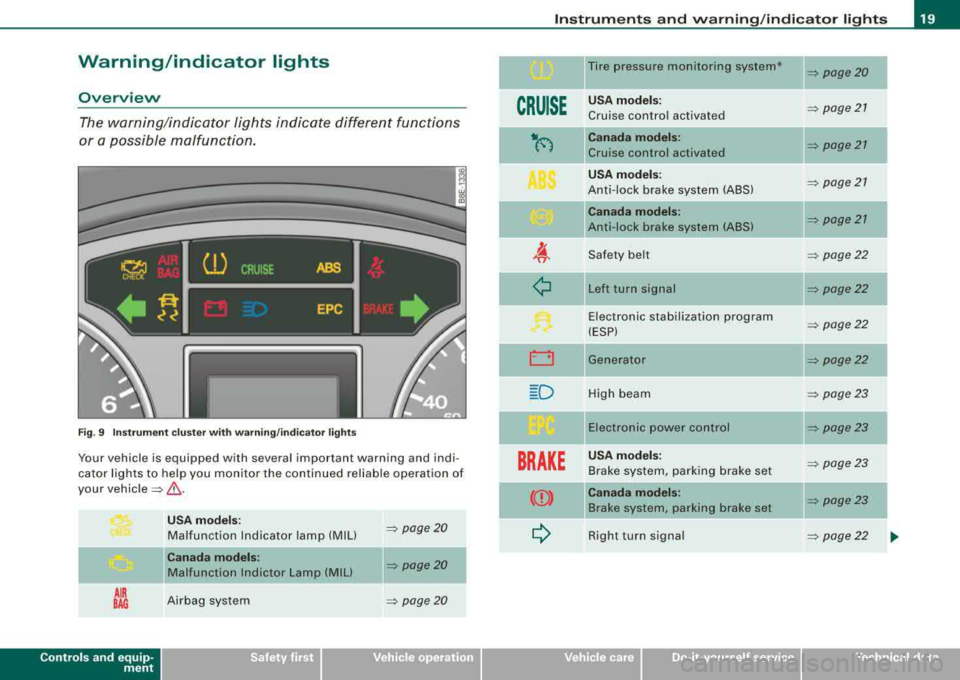
Warning/indicator lights
Overview
The warning/indicator lights indicate different functions
or a p ossible malfunction.
Fig . 9 Instrume nt cluste r wi th warn ing/ ind ica tor l ights
Your vehicle is equipped with several important warning and indi
cator lights to help you monitor the continued reliable operation of
your vehicle
=> & .
AIR
BAG
Controls and equip
ment U
SA mod els:
Ma lfunction Indicato r lamp {MIU => page 20
Canad a mo del s:
Malfunction lndictor Lamp {MIU => page20
Airbag system => page 20
Inst rum ents and w arning /indi cator li ght s
Tire pressure monitoring system* => page20
CRUISE
USA model s: => page21 Cruise contro l activated
-ti(') Can ada mod els: => page21 Cruise control activated
U SA m odel s: => page 21 Anti-lock brake system {ABS)
Canad a model s: => page 21 Anti-lock brake system {ABS)
~ Safety belt => page22
·-
¢ Left turn signal => page22
Electronic stabi lization program => page22 {ESP)
D Generator => page22
D High beam => page 23
Electronic power control => page23
BRAKE
U SA model s: => page23 Brake system, parking brake set
CCD>
Canad a model s: => page23 Brake system, parking brake set •
c> Right turn signal => page 22 .,,
irechnical data
Page 23 of 368
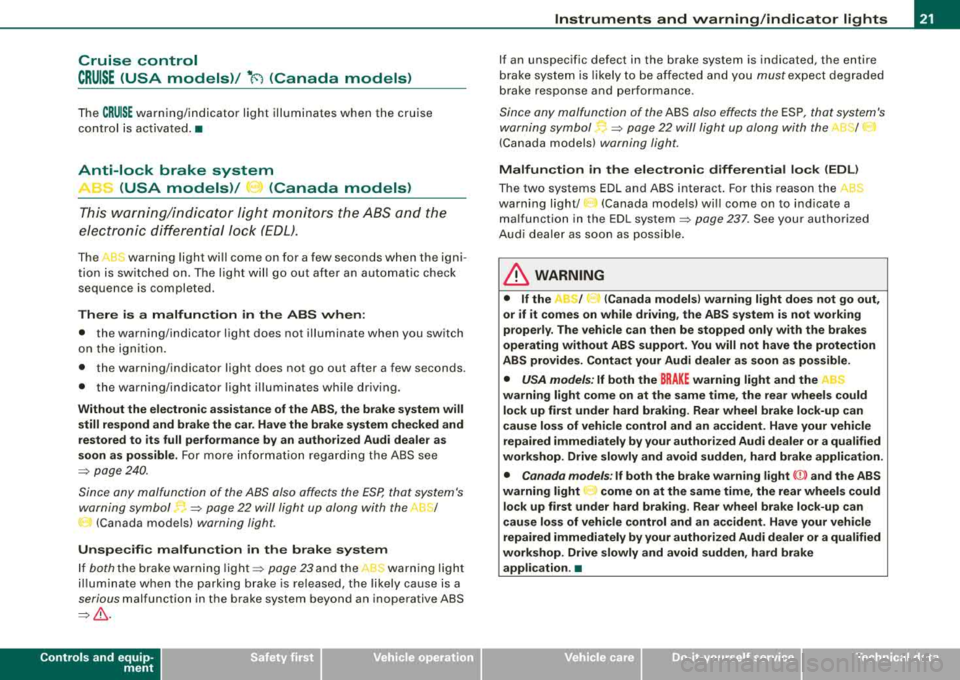
Cruise control
CRUISE (USA models)/ ·~ (Canada models)
The CRU ISE wa rn in g/ ind icato r light illuminates whe n the cruise
control is act ivated. •
Anti-lock brake system
ABS (USA models)/
<0 (Canada models)
This warning /indicator light mon itor s the ABS and the
e lec tr oni c di fferent ial loc k (EDL ).
The ABS warning light will come on for a few seconds when the igni
t ion is sw itched on. T he lig ht wi ll go out a fter an autom ati c ch eck
sequenc e is complet ed .
There is a malfunction in the ABS when :
• the warning/indicator light does not ill uminate when you switch
o n t he ign ition .
• the warning/indicator light does not go out after a few seconds .
• the warning/i ndicator light illu minates while driving .
Without the electronic assistance of the ABS , the brake system will
still respond and brake the car . Have the brake system checked and
restored to its full performance by an authorized Audi dealer as
soon as possible.
Fo r m ore info rm ation re gar din g th e ABS s ee
=> pa ge 24 0.
Since any malfunction of the AB S also affects the
ESP, that s ystem's
warning symbol !;.
=> page 22 will light up along with the ABS/
0 (Canada mode ls) warning light.
Unspecific malfun ction in the brake system
If both th e bra ke warn ing lig ht => page 23 and the ABS w arn ing l ig ht
illum inate when t he park in g brake is released, t he likely cause is a
serious malfunction in the brake system beyond an inoperative AB S
=>& .
Controls and equip
ment
Instruments and warning /indicator lights
If an unsp ecific defect in the brake system is indicated, the entire
br ak e syste m is lik ely to be a ffec ted a nd you
mus t exp ect deg ra d ed
b rake r espons e and performance .
Since any malfunction of the ABS also effects the ESP , that system 's
w ar ning symbol
f;.. => page 2 2 will l ight up alo ng with th e ABS/ 0
(Canada models) warning light.
Malfunction in the electroni c differential lock
(EDL )
The two systems ED L and ABS interact . For th is reason the ABS
warning light/ 8 (Canada mode ls) wi ll come on to ind icate a
ma lfunction in the EDL syste m
=> page 237. See your authorized
Aud i deale r as s oon as poss ible.
& WARNING
• If the ABS/ 8 (Canada models) warning light does not go out ,
or if it comes on while driving, the ABS system is not working
properly . The vehicle can then be stopped only with the brakes
operating without ABS support . You will not have the protection
ABS provides. Contact your Audi dealer as soon as possible.
• USA models : If both the BRAKE warning light and the ABS
warning light come on at the same time, the rear wheels could lock up first under hard braking. Rear wheel brake lock-up can
cause loss of vehicle control and an accident . Have your vehicle
repaired immediately by your authorized Audi dealer or a qualified
workshop. Drive slowly and avoid sudden , hard brake application .
• Canada models : If both the brake warning light ((DJ and the ABS
warning light
0 come on at the same time , the rear wheels could
lock up first under hard braking. Rear wheel brake lock-up can
cause loss of vehicle control and an accident . Have your vehicle
repaired immediately by your authorized Audi dealer or a qualified
workshop. Drive slowly and avoid sudden, hard brake
application. •
Page 24 of 368

Instruments and warnin g/indi cat or li ghts
Safety belts i
This warning/indicator light reminds y ou to put on your
safety belt.
The .ft warning/indicator light i lluminates when the ignition is
switched on to remind the driver and (on USA mode ls only) any front
passenger to put on the safety belt. Additiona lly, an acoustic
warn ing (gong) w ill also sound.
For more
information~ page 176 , "Safety belt warning light 4". •
Turn signals ¢ ¢
The in dicator light flashes when you use either turn
signal.
Whenever you use the left ¢ or the right ¢ turn signal, the indicator
l ight flashes. W hen you use the emerge ncy flasher, both indicator
lights f lash .
I f one of the turn signal light bulbs burn out, the turn signal will
flash twice as fast as normal. •
Electronic Stabilization Program (ESP) fJ
The warning/indicator ligh t monit ors the electr onic s tabi
lization program.
The ~ warning/indicator light has the fol lowing functions:
• it flashes while you are driving, when the ESP is working .
• it illuminates when you switch on the ignition for approximately
2 seconds as a funct ion check.
• it illuminates when there is a ma lfunction in the ESP.
• it illuminates after the battery has been disconnected .
• it illuminates continuous ly when the ESP is switched off . •
it illuminates if there is a malfunction in the ABS, since the ESP
is part o f the ABS system.
If the ESP warning/indicator light illuminates and stays on after you
have started the engine, this may mean that the control system has
temporar ily switched o ff the ESP . If this is case, you can reactivate
the ESP by switching the ignition off and then on again . The
warning/indicator light should go out to show that the system is
ful ly functional again .
I f the battery terminals were disconnected and re -connected, the
vehic le was jump started or the battery is very weak, the ESP sensor
system goes through a learning p rocess for the firs t few yards.
D uring th is time, t he ind icator l ight i llu minates. It goes out as soo n
as the learning process is comp lete.
For more information about the
ESP ~ page 236. •
Generator 0
T his warning/indicator light detects a malfunction in the
generator or i n t he vehicle's elec trical system.
T he O warning/indicator light i lluminates w hen you switch on the
ignition and must go out after the engine has started .
I f the
O warni ng/ind icator light illum inates while you a re driv ing,
you shou ld contact your authorized Audi dealer . Since the vehicle
battery is dischargi ng, you should sw itch off any unnecessary elec
trical consumers (for example, the air conditioner) .
0 Note
If the _JL warning/indicator light (ma lfunction in the engine coo ling
system) i n the instrument cluster shou ld
i llumi nate ~ page 31, stop
the ve hicle and turn o ff the engine . The coo lant pump is not work ing
-this can cause engine damage! •
Page 25 of 368

High beam [D
The ~D warning/indicator light il lu m inates when the high beams are
on or w hen you use the head lig ht flash er. For mo re inf ormation
about using the h igh beams,
see=> page 80 . •
Electronic power control EPC
Th is warn ing /indicator l ig ht m on ito rs the ele ctr onic
po wer co nt rol.
The EPC warning/indicator light (E lectronic Power Control) illumi
n at es w he n yo u switch o n the ignitio n as a functi on ch ec k.
[ i] Tips
If thi s wa rning/indi cator light i llum ina tes w hile you a re driving , then
there is a ma lfunction in the engine electronics . Have the malfunc
t io n co rre cte d as so on as p oss ible by your auth orized Audi de aler or
qualified wor kshop .•
Brake system BRAKE (USA models)/ (CD)
(Canada models)
Th is warn ing /indicator l ight i llu minates when the brake
fl uid leve l is t oo low or wh en ther e is a ma lf u nct io n in t he
ABS , or when the pa rkin g brake i s se t.
T he lig ht illu min ate s w hen the igni tio n is turn ed on. It goes out aft er
the engine has be en started and the parking bra ke is fu lly released .
T his i ndicate s th at th e br ake w arni ng lig ht is fun cti onin g prop erl y.
If the brake warning light does not light up when the engine is
cranking or the parking brake is applied , there may be a malfunction
in the electrical system. In this case, contact your Audi dealer.
When the l ig ht comes on, an audible warning si gnal is also given.
Controls and equip
ment
Instruments and warning /indicator lights
Parking brake set
T he BRAKE or CCD) (Canada) wa rning/indicat or l igh t illum in ate s wh en
t h e pa rkin g b rake is
se t=> ,&.
& WARNING
• USA models : If the BRAKE warning light and the ABS warning
light come on together , the rear wheels could lock up first under
hard braking . Rear wheel lock-up can cause loss of vehicle control
and an accident . Have your vehicle repaired immediately by your
authorized Audi dealer or a qualified workshop. Drive slowly and
avoid sudden, hard brake applications.
• Canada models : If the brake warning light
{(j)) and the ABS
warning light
0 come on together , the rear wheels could lock up
first under hard braking . Rear wheel lock-up can cause loss of
vehicle control and an accident. Have your vehicle repaired imme
diately by your authorized Audi dealer or a qualified workshop .
Drive slowly and avoid sudden , hard brake applications.
• If the brake warning/indicator light does not go out after a few
seconds and the parking brake released, or lights up while you are
driving, the fluid level in the brake fluid reservoir is too low. If you
believe that it is safe to do so , proceed immediately at low speed
to the nearest authorized Audi dealer or qualified repair facility and have the brake system inspected .
• Always keep in mind that after several brake applications , you
will need greater pressure on the brake pedal to stop your vehicle .
Do not rely on strained brakes to respond with maximum stopping
power in critical situations . You must allow for increased braking
distances . The extra distance u sed up by fading brakes could lead
to an accident . •
Page 33 of 368
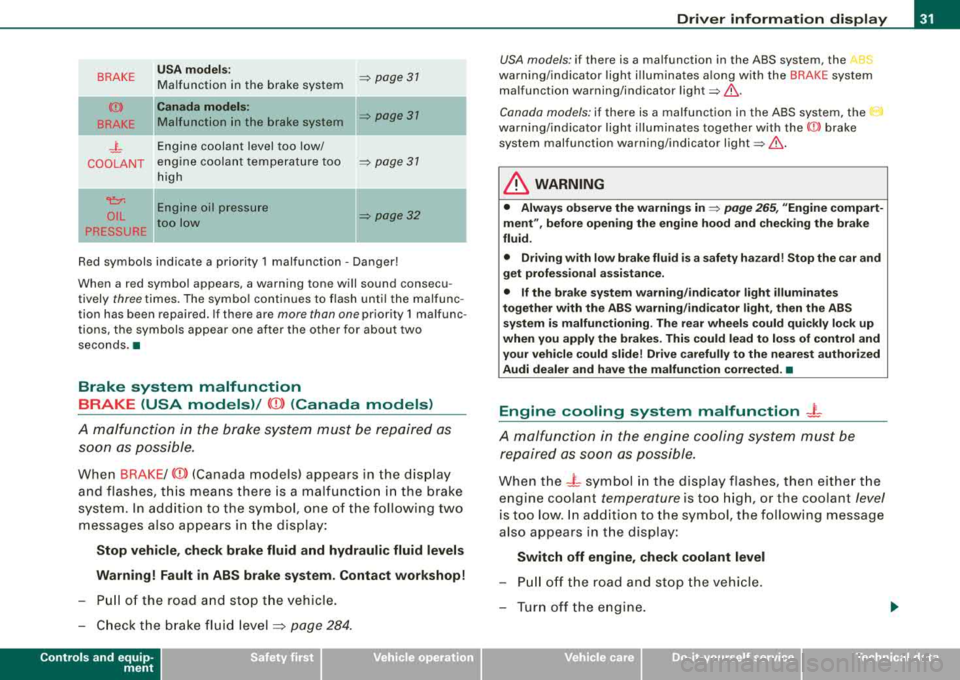
BRAKE
(Ci))
BRAKE
_j_
COOLANT
~
OIL
PRESSURE USA
models:
Malfunction in the brake system
Canada models:
Malfunction in the brake system
Engine coolant level too low/
engine coolant temperature too
high
-
Engine oil pressure
too low =>
page 31
=> page 31
=> page 31
=> page 32
Red symbols indicate a priority 1 malfunction -Danger!
When a red symbol appears , a warning tone will sound consecu
tively three times. The symbol continues to flash until the malfunc
tion has been repaired. If there are more than one priority 1 malfunc
tions, the symbols appear one after the other for about two
seconds .a
Brake system malfunction BRAKE (USA models)/
(CD) (Canada models)
A malfunction in the brake system must be repaired as soon as possible.
When BRAKE/ (CD) (Canada models) appears in the display
and flashes, this means there is a malfunction in the brake
system. In addition to the symbol, one of the following two
messages also appears in the display:
Stop vehicle, check brake fluid and hydraulic fluid levels
Warning! Fault in ABS brake system. Contact workshop!
- Pull of the road and stop the vehicle.
- Check the brake fluid
level :::;, page 284.
Controls and equip
ment
Driver information display
USA models : if there is a malfunction in the ABS system, the ABS
warning/indicator light illuminates along with the BRAKE system
malfunction warning/indicator
light=> ,&..
Canada models: if there is a malfunction in the ABS system, the 0
warning/indicator light illuminates together with the ((l)) brake
system malfunction warning/indicator
light =>,&. .
& WARNING
• Always observe the warnings in => page 265, "Engine compart
ment", before opening the engine hood and checking the brake
fluid.
• Driving with low brake fluid is a safety hazard! Stop the car and
get professional assistance.
• If the brake system warning/indicator light illuminates
together with the ABS warning/indicator light, then the ABS
system is malfunctioning. The rear wheels could quickly lock up
when you apply the brakes. This could lead to loss of control and
your vehicle could slide! Drive carefully to the nearest authorized
Audi dealer and have the malfunction corrected. •
Engine cooling system malfunction -L
A malfunction in the engine cooling system must be
repaired as soon as possible.
When the - L symbol in the display flashes, then either the
engine coolant
temperature is too high, or the coolant level
is too low. In addition to the symbol, the following message
also appears in the display:
Switch off engine, check coolant level
- Pull off the road and stop the vehicle.
- Turn off the engine.
Page 176 of 368
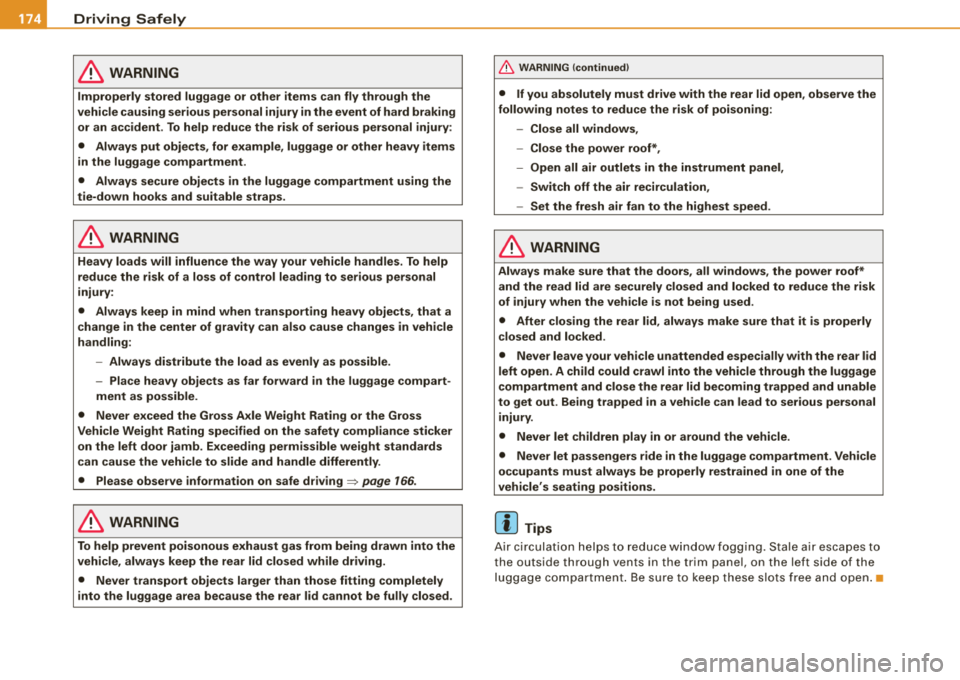
___ D_ r
_ i_v _i_n ..;::g :;_ S_ a_ f_ e_, ly'----------------------------------------------------
& WARNING
Improperly stored luggage or other items can fly through the
vehicle causing serious personal injury in the event of hard braking
or an accident. To help reduce the risk of serious personal injury:
• Always put objects, for example, luggage or other heavy items
in the luggage compartment .
• Always secure objects in the luggage compartment using the
tie-down hooks and suitable straps .
& WARNING
Heavy loads will influence the way your vehicle handles. To help
reduce the risk of a loss of control leading to serious personal
injury :
• Always keep in mind when transporting heavy objects, that a
change in the center of gravity can also cause changes in vehicle
handling:
-Always distribute the load as evenly as possible.
- Place heavy objects as far forward in the luggage compart-
ment as possible.
• Never exceed the Gross Axle Weight Rating or the Gross
Vehicle Weight Rating specified on the safety compliance sticker on the left door jamb. Exceeding permissible weight standards
can cause the vehicle to slide and handle differently.
• Please observe information on safe
driving => page 166.
& WARNING
To help prevent poisonous exhaust gas from being drawn into the
vehicle, always keep the rear lid closed while driving.
• Never transport objects larger than those fitting completely
into the luggage area because the rear lid cannot be fully closed.
& WARNING (continued)
• If you absolutely must drive with the rear lid open, observe the
following notes to reduce the risk of poisoning :
- Close all windows,
- Close the power roof*,
- Open all air outlets in the instrument panel,
- Switch off the air recirculation,
- Set the fresh air fan to the highest speed.
& WARNING
Always make sure that the doors, all windows, the power roof*
and the read lid are securely closed and locked to reduce the risk
of injury when the vehicle is not being used.
• After closing the rear lid, always make sure that it is properly
closed and locked.
• Never leave your vehicle unattended especially with the rear lid
left open. A child could crawl into the vehicle through the luggage
compartment and close the rear lid becoming trapped and unable
to get out . Being trapped in a vehicle can lead to serious personal
injury.
• Never let children play in or around the vehicle.
• Never let passengers ride in the luggage compartment . Vehicle
occupants must always be properly restrained in one of the
vehicle's seating positions.
[ i] Tips
Air circulation helps to reduce window fogging. Stale air escapes to
the outside through vents in the trim panel, on the left side of the
luggage compartment. Be sure to keep these slots free and open. •
Page 180 of 368
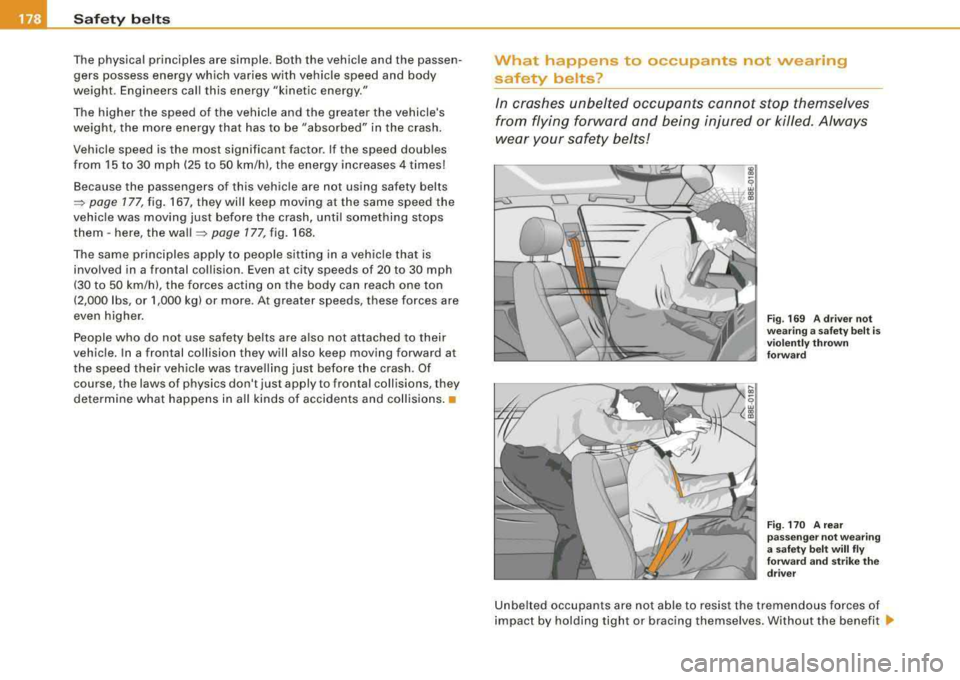
___ s_a_ f_ e_ t-= y_ b_e_ l_ t _s _______________________________________________ _
T he physical principles are simple . Both the vehicle and the passen
gers possess energy wh ich varies w ith vehicle speed and body
weight . Engineers cal l this energy "kinetic energy ."
The higher the speed of the vehicle and the greater the vehicle's
weight, the more energy that has to be "absorbed" in the crash.
Vehicle speed is the most significant factor . If the speed doub les
from 15 to 30 mph (25 to 50 km/h), the energy increases 4 times!
Because the passengers of this vehicle are not using safety belts
~ page 177, fig. 167, they will keep moving at the same speed the
vehic le was moving just before the crash, until something stops
them
-here, the wall ~ page 177, fig . 168 .
The same principles apply to people sitting in a vehicle that is involved in a frontal collision . Even at city speeds of 20 to 30 mph
(30 to 50 km/h), the forces acting on the body can reach one ton
(2,000 lbs, or 1,000 kg) or more. At greater speeds, these forces are
even higher.
People who do not use safety belts are a lso not attached to their
vehic le. In a frontal collision they will also keep moving forward at
the speed their vehicle was trave lling just before the crash. Of
course, the laws of physics don't just apply to frontal collisions, they
determine what happens in all kinds of accidents and coll isions .•
What happens to occupants not wearing
safety belts?
In crashes unbelted occupants cannot stop themselves
from flying forward and being injured or killed . Always
wear your safety belts!
0
F ig . 169 A driver not
wear ing a safety belt is
v iol ently thr own
forwa rd
Fig. 17 0 A rear
passenge r not wearing
a safe ty belt w ill
fly
for wa rd a nd strik e the
dr iver
Unbelted occupants are not able to resist the tremendous forces of
impact by holding tight or bracing themselves . Without the benefit ._
Page 181 of 368
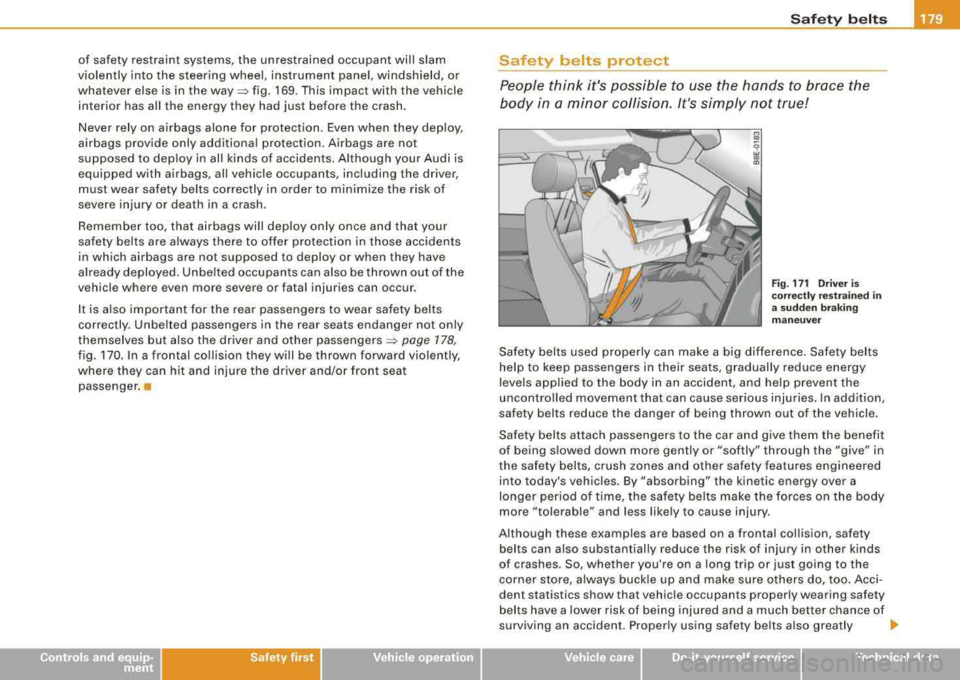
of safety restraint systems, the unrestrained occupant will slam
violently into the steering wheel, instrument panel, windshield, or
whatever else is in the
way=> fig . 169. This impact with the vehicle
interior has all the energy they had just before the crash.
Never rely on airbags alone for protection . Even when they dep loy,
airbags provide only additional protection . Airbags are not
supposed to deploy in all kinds of accidents . Although your Audi is
e quipped wi th airbags, all vehicle occupan ts , including the driver,
must wear safety belts correctly in order to minimize the risk of
severe injury or death in a crash .
Remember too, that airbags will deploy only once and that your
safety belts are always there to offer protection in those accidents
in which airbags are not supposed to deploy or when they have
already deployed . Unbelted occupants can also be thrown out of the
vehicle where even more severe or fatal injuries can occur.
It is also important for the rear passengers to wear safety belts
correctly . Unbelted passengers in the rear seats endanger not only
themselves but also the driver and other
passengers~ page 178,
fig. 170. In a frontal collision they will be thrown forward violently,
where they can hit and injure the driver and/or front seat
passenger. •
Safety first
Safety belts
Safety belts protect
People think it's possible to use the hands to brace the
body in a minor collision. It's simply not true!
&l
9 w a, a,
Fig. 171 Driver is
correctly restrained in
a sudden braking
maneuver
Safety belts used properly can make a big difference. Safety belts
help to keep passengers in their seats, gradually reduce energy
levels applied to the body in an accident, and help prevent the
uncontrolled movement that can cause serious injuries. In addition ,
safety belts reduce the danger of being thrown out of the vehicle .
Safety belts attach passengers to the car and give them the benefit
of being slowed down more gently or "softly" through the "give" in
the safety belts, crush zones and other safety features engineered
into today's vehicles. By "absorbing" the kinetic energy over a
longer period of time, the safety belts make the forces on the body
more "tolerable" and less likely to cause injury .
Although these examples are based on a frontal collision, safety belts can also substantially reduce the risk of injury in other kinds
of crashes. So, whether you're on a long trip or just going to the
corner store, a lways buckle up and make sure others do, too . Acci
dent statistics show that vehicle occupants properly wearing safety
belts have a lower risk of being injured and a much better chance of
surviving an accident . Properly using safety belts also greatly .,,_
irechnical data
Page 194 of 368
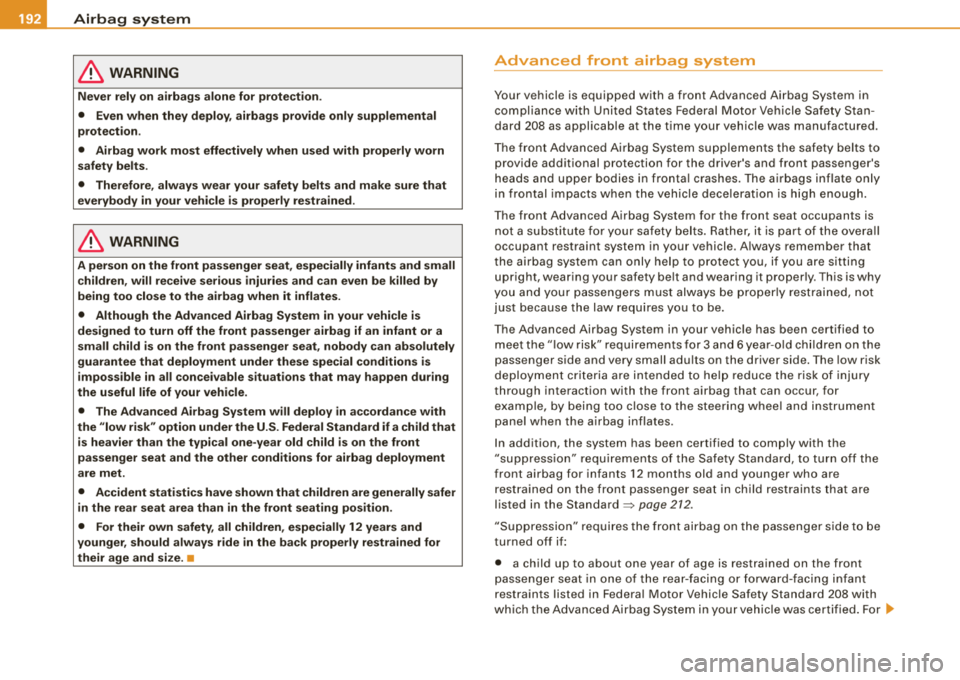
-Airbag system
----:=-..:....--------------------------------------------
& WARNING
Never rely on airbags alone for protection.
• Even when they deploy, airbags provide only supplemental
protection .
• Airbag work most effectively when used with properly worn
safety belts.
• Therefore, always wear your safety belts and make sure that
everybody in your vehicle is properly restrained.
& WARNING
A person on the front passenger seat, especially infants and small children, will receive serious injuries and can even be killed by
being too close to the airbag when it inflates.
• Although the Advanced Airbag System in your vehicle is
designed to turn off the front passenger airbag if an infant or a
small child is on the front passenger seat, nobody can absolutely
guarantee that deployment under these special conditions is
impossible in all conceivable situations that may happen during
the useful life of your vehicle.
• The Advanced Airbag System will deploy in accordance with
the
"low risk" option under the U.S. Federal Standard if a child that
is heavier than the typical one-year old child is on the front
passenger seat and the other conditions for airbag deployment
are met.
• Accident statistics have shown that children are generally safer
in the rear seat area than in the front seating position.
• For their own safety, all children, especially 12 years and
younger, should always ride in the back properly restrained for
their age and size.
•
Advanced front airbag system
Your vehicle is equipped with a front Advanced Airbag System in compliance with United States Federal Motor Vehicle Safety Stan
dard 208 as applicable at the time your vehicle was manufactured .
The front Advanced Airbag System supplements the safety belts to
provide additional protection for the driver's and front passenger's
heads and upper bodies in frontal crashes. The airbags inflate only
in frontal impacts when the vehicle deceleration is high enough.
The front Advanced Airbag System for the front seat occupants is
not a substitute for your safety belts. Rather, it is part of the overall
occupant restraint system in your vehicle . Always remember that
the airbag system can only help to protect you, if you are sitting
upright, wearing your safety belt and wearing it properly. This is why
you and your passengers must always be properly restrained, not
just because the law requires you to be.
The Advanced Airbag System in your vehicle has been certified to
meet the "low risk" requirements for 3 and 6 year-old children on the
passenger side and very small adults on the driver side. The low risk
deployment criteria are intended to help reduce the risk of injury
through interaction with the front airbag that can occur, for example, by being too close to the steering wheel and instrument
panel when the airbag inflates .
In addition, the system has been certified to comply with the
"suppression" requirements of the Safety Standard, to turn off the
front airbag for infants 12 months old and younger who are
restrained on the front passenger seat in child restraints that are
listed in the
Standard~ page 272 .
"Suppression" requires the front airbag on the passenger side to be
turned off if:
• a child up to about one year of age is restrained on the front
passenger seat in one of the rear-facing or forward-facing infant
restraints listed in Federal Motor Vehicle Safety Standard 208 with
which the Advanced Airbag System in your vehicle was certified. For
~
Page 204 of 368

-Airbag system ---=--.:..,.._ _________________________________ _
&, WARNING (continued )
cellular telephones and CB radios, etc .) must be performed by a
qualified technician who has the training and special equipment
necessary .
• For any work on the airbag system , we strongly recommend
that you see your authorized Audi dealer or qualified workshop .
• Never modify the front bumper or parts of the vehicle body .
• Always make sure that the side airbag can inflate without inter
ference :
- Never install seat covers or replacement upholstery over the
front seatba cks that have not been specifically approved by
Audi.
- Never use additional seat cushions that cover the areas
where the side airbags inflate.
- Damage to the original seat covers or to the seam in the area
of the side airbag module must always be repaired immedi
ately by an authorized Audi dealer .
• The airbag system can be activated only once. After an airbag
has inflated , it must be replaced by an authorized Audi dealer or
qualified technician who has the technical information , training
and special equipment necessary.
• The airbag system can be deployed only once. After an airbag
has been deployed, it must be replaced with new replacement
parts designed and approved especially for your Audi model
version. Replacement of complete airbag systems or airbag
components must be performed by qualified workshops only .
Make sure that any a irbag service action is entered in your Audi
Maintenance
& Warranty booklet under AIRBAG REPLACEMENT
RECORD .
• In accidents when an airbag is deployed, the vehicle battery
separates the alternator and the starter from the vehi cle electrical
system for safety reasons with a pyrotechnic circuit interrupter.
-Work on the pyrotechni c circuit interrupter must only be
performed by a qualified dealer -risk of an accident !
&, WARNING (continued )
-If the vehicle or the circuit interrupter is scrapped, all appli
cable safety precautions must be followed.
•
Other things that can affect Advanced Airbag performance
Changing the vehic le 's suspension system can change the way that
t he A dvance d Ai rbag S ystem p erf o rm s in a c rash. F or example,
using tire -rim combinations not approved by Audi, lowerin g the
ve hicle , ch ang ing the stiff ness of the suspe nsion, includ ing the
springs, suspension struts, shock absorbers etc. can chang e the
fo rces that a re measured by the airbag senso rs and se nt to the elec
tronic control u nit. Some suspension chan ges can, for exampl e,
i n crease the fo rce level s measured by the sen so rs and ma ke the
a irbag s yste m de plo y in cras he s in w hi ch it wou ld not de ploy if th e
changes had not been made. Other kinds of changes may reduce
t h e fo rce lev els measu red by the senso rs a nd p reven t the airb ag
from dep loying when it should.
T he sens ors i n the safe ty belt buckle f or the dri ve r and front
passeng er seat tell t he electronic contro l modu le if the safety belt is
la tched o r not. If t he sa fe ty bel t i s being used, the fro nt ai rbag wi ll
deploy at a s ligh tly high er rate o f veh icle dece lerat io n th an if th e
safety be lt is not being u sed . Th erefo re , in a particula r co llision, it is
poss ib le th at a n airbag will not deplo y at a seat ing po sit io n wh ere
the safety be lt is being used but wi ll inflate at the pos ition where the
safety be lt is not bei ng used . It is im po rta nt tha t noth ing i nte rfere
with the safety belt buc kles so that the sensors can send the correct
i nf orm atio n abou t s afe ty belt use to th e electr onic co ntrol uni t.
~